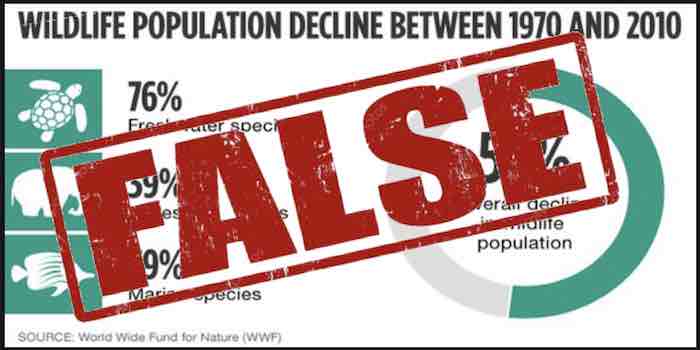By Jack Dini ——Bio and Archives--March 14, 2023
Global Warming-Energy-Environment | CFP Comments | Reader Friendly | Subscribe | Email Us

Two independent groups of scientists have destroyed the always improbable claim that vertebrates across the planet have declined by 69 percent since 1970 made by the World Wildlife Fund and the Zoological Society of London. (1)
A group of Canadian biologists has shown that the figure is a statistical freak. They reveal that the estimate is driven by 2.4 percent of wildlife populations, adding, "If these extremely declining populations are excluded, the global trend switches to an increase."
It is a bedrock climate and ecological scare story repeated endlessly in the mainstream media and broadcast everywhere from UN platforms to school classrooms.
Less inspiring might have been the message that 2.4 percent of vertebrate populations are currently doing badly--it's nature, it happens--but the rest on average are just dandy. (1)
Willis Eschenbach asks this question; what are the names of all the extinct birds and mammal supposedly gone? The record of continental (as opposed to island) bird and mammal extinctions in the last five centuries was analyzed to determine if 'species-area' relationship actually works to predict relationships. Very few continental birds or mammals are recorded as having gone extinct from habitat reduction alone. No continental forest bird or mammal is recorded as having gone extinct from any cause since the species-area relationship predicts that there should have been a very large number of recorded bird and mammal extinctions from habitat reduction over the last millennium shows that the species-area relationship gives erroneous answers to the question of extinction rate.(2)
Earlier it was mentioned that if a 2.4 percent declining population is excluded, the global trend switches to an increase. Larry Krummer agrees. He reports that a close review of the most recent information dating back to 1870 reveals that instead of a frightening increase, extinctions are actually in a significant decline. What is apparent is that the trend of extinctions is declining rather increasing, just the opposite of what many report. Also, according to a UN report, we can expect 25,000 to 30,000 extinctions per year, yet the average over the last years is about 2 species annually. That means the rate would have to multiply by 12,500 to 15,000 to reach the dizzying heights predicted.
Nothing on the horizon is likely to achieve even a small fraction of that. This extinction study is just the latest example of misuse and abuse of the scientific process designed to sow fear of an impending climate apocalypse. (3)
This latest debunking of a cherished green scare is further bad news for publicity seeking climate catastrophists. Introducing the report, The Zoological Society also noted that a 0.3C warming would result in a loss of up to 90% of warm water coral, a scare that has a very 'last decade' look about it, given that corals in the Great Barrier Reef and elsewhere have rarely been in better shape. Slowly recovering Arctic ice, including the Greenland ice shelf, plateauing global surface temperature, and more polar bears hunting more seals, have all added to the recent misery. (1)
View Comments
Jack Dini is author of Challenging Environmental Mythology. He has also written for American Council on Science and Health, Environment & Climate News, and Hawaii Reporter.